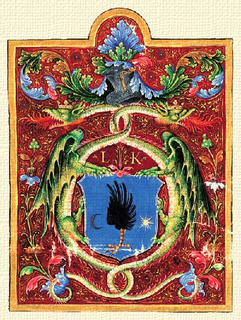Related Research Articles
The Middle Ages in Romania began with the withdrawal of the Mongols, the last of the migrating populations to invade the territory of modern Romania, after their attack of 1241–1242. It came to an end with the reign of Michael the Brave (1593–1601) who managed, for a short time in 1600, to rule Wallachia, Moldavia, and Transylvania, the three principalities whose territories were to be united some three centuries later to form Romania.

The historical regions of Romania are located in Central, Southeastern, and Eastern Europe. Romania came into being through the unification of two principalities, Wallachia and Moldavia in 1862. The new unitary state extended over further regions at various times during the late 19th and 20th centuries, including Dobruja in 1878, and Transylvania in 1918.
The Prince of Transylvania was the head of state of the Principality of Transylvania from the last decades of the 16th century until the middle of the 18th century. John Sigismund Zápolya was the first to adopt the title in 1570, but its use only became stable from 1576.
The history of Christianity in Romania began within the Roman province of Lower Moesia, where many Christians were martyred at the end of the 3rd century. Evidence of Christian communities has been found in the territory of modern Romania at over a hundred archaeological sites from the 3rd and 4th centuries. However, sources from the 7th and 10th centuries are so scarce that Christianity seems to have diminished during this period.

The Voivode of Transylvania was the highest-ranking official in Transylvania within the Kingdom of Hungary from the 12th century to the 16th century. Appointed by the monarchs, the voivodes – themselves also the heads or ispáns of Fehér County – were the superiors of the ispáns of all the other counties in the province.

The judge royal, also justiciar, chief justice or Lord Chief Justice, was the second-highest judge, preceded only by the palatine, in the Kingdom of Hungary between around 1127 and 1884. After 1884, the judge royal was only a symbolic function, but it was only in 1918 — with the end of Habsburgs in the Kingdom of Hungary — that the function ceased officially.
János Jacobinus was a Hungarian politician and historian of Saxon origin in the Principality of Transylvania, who served as Chancellor of Transylvania for a short time in 1603.
László Sombori was a Hungarian noble in the Principality of Transylvania, member of the Royal Council, who served as Governor of Transylvania for the underage voivode Sigismund Báthory from 6 March 1583 to 1 May 1585.

The Master of the doorkeepers was a high-ranking official in the Kingdom of Hungary from the beginning of the 11th century to 1945. Formerly, the office was known as Ispán of the keepers.
Márton Berzeviczy de Berzevicze et Kakaslomnicz was a Hungarian noble and diplomat in the Principality of Transylvania, who served as Chancellor of Transylvania for Stephen Báthory between January 1578 and 1586.

The chief justice was the personal legal representative of the King of Hungary, who issued decrees of judicial character on behalf of the monarch authenticated with the royal seal, performed national notarial activities and played an important role in the organisation of lawyers training. Later the chief justice was the head of the Royal Court of Justice and the Tribunal of the Chief Justice, the highest legal forum of civil cases.
Raphael or Raphain was a Hungarian distinguished nobleman, who served as voivode of Transylvania in 1217, during the reign of Andrew II of Hungary. He might have been also in office in 1218.
John was a Hungarian distinguished nobleman, who served as voivode of Transylvania in 1273, during the reign of Ladislaus IV of Hungary.
Finta from the kindred Aba was a Hungarian lord in the Kingdom of Hungary, who served as Palatine of Hungary from 1280 to 1281. He is best known for capturing King Ladislaus IV of Hungary in early 1280.

The royal treasurer, or simply treasurer, also royal purse-bearer, was an official in the Hungarian royal court, existed around from the 1320s to the 16th century. The position evolved from the royal dignity of Master of the treasury, which gradually adopted more and more judiciary functions over the centuries, thus the newly established royal treasurer put in charge of collecting and administering royal revenues in practice.
Stephen (I) Lackfi was an influential nobleman and a successful military leader in the Kingdom of Hungary. He played a significant role in the Neapolitan campaigns of Louis the Great.

Baron Péter Perényi was a Hungarian aristocrat who held the office of voivode of Transylvania from 1526 to 1529. He was an influential protector of Protestant preachers in the Kingdom of Hungary.

Ladislaus Kanizsai, was a military commander and officer of state in the Kingdom of Hungary in the 15th century.
References
- (in Hungarian) Fallenbüchl, Zoltán (1988). Magyarország főméltóságai [=High Dignitaries in Hungary]. Maecenas Könyvkiadó. ISBN 963-02-5536-7.
- (in Hungarian) Markó, László: A magyar állam főméltóságai Szent Istvántól napjainkig – Életrajzi Lexikon. (The High Officers of the Hungarian State from Saint Stephen to the Present Days – A Biographical Encyclopedia) (2nd edition); Helikon Kiadó Kft., 2006, Budapest; ISBN 963-547-085-1.
- Treptow, Kurt W.; Popa, Marcel (1996). Historical Dictionary of Romania. Scarecrow Press, Inc. ISBN 0-8108-3179-1.